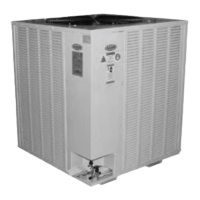If the velocity of refrigerant in the liquid line
is too great, it could cause excessive noise or
piping erosion. The recommended
maximum velocities for liquid lines are 100
fpm from the condenser to a receiver tank to
discourage fluid backup, and 300 fpm from
receiver tank to the evaporator to minimize
valve induced liquid hammer.
Liquid Line Accessories
Liquid line shut off valves and filter driers
are factory provided. Filter driers must be
field installed. The total length equivalent of
pressure losses through valves, elbows and
fittings must be considered when adding
additional components in the field. It is a
good practice to utilize the fewest elbows
that will allow the mating units to be
successfully joined.
A solenoid valve is recommended on lines
over 100ft in length to prevent liquid
migration when the compressors are off.
The solenoid needs to be wired so that it is
open when the compressors turn on, and
closed when the compressors turn off.
Suction Line Sizing
The suction line is more critical than the
liquid line from a design and construction
standpoint. More care must be taken to
ensure that adequate velocity is achieved to
return oil to the compressor at minimum
loading conditions. However, reducing the
piping diameter to increase the velocity at
minimal load can result in excessive
pressure losses, capacity reduction, and
noise at full load.
Suction Line Routing
Pitch the suction line in the direction of flow
(about 1 foot per 120 feet of length) to
maintain oil flow towards the compressor,
and keep it from flooding back into the
evaporator. Crankcase heaters are provided
to keep any condensed refrigerant that
collects in the compressor from causing
damage or wear. Make sure to provide
support to maintain suction line positioning,
and insulate completely between the
evaporator and condensing unit.
It is important to consider part load
operation when sizing suction lines. At
minimum capacity, refrigerant velocity may
not be adequate to return oil up the vertical
riser. Decreasing the diameter of the vertical
riser will increase the velocity, but also the
frictional loss.
For difficult line routing applications, a
double suction riser can be applied to the
situation of part load operation with a
suction riser. A double suction riser is
designed to return oil at minimum load
while not incurring excessive frictional
losses at full load. A double suction riser
consists of a small diameter riser in parallel
with a larger diameter riser, and a trap at the
base of the large riser. At minimum
capacity, refrigerant velocity is not sufficient
to carry oil up both risers, and it collects in
the trap, effectively closing off the larger
diameter riser, and diverting refrigerant up
the small riser where velocity of the
refrigerant is sufficient to maintain oil flow.
At full load, the mass flow clears the trap of
oil, and refrigerant is carried through both
risers. The smaller diameter pipe should be
sized to return oil at minimum load, while
the larger diameter pipe should be sized so
that flow through both pipes provides
acceptable pressure drop at full load.
SUCTION LINE SIZING
Suction line must be sized in
accordance to the minimum capacity
of the variable speed compressor.

